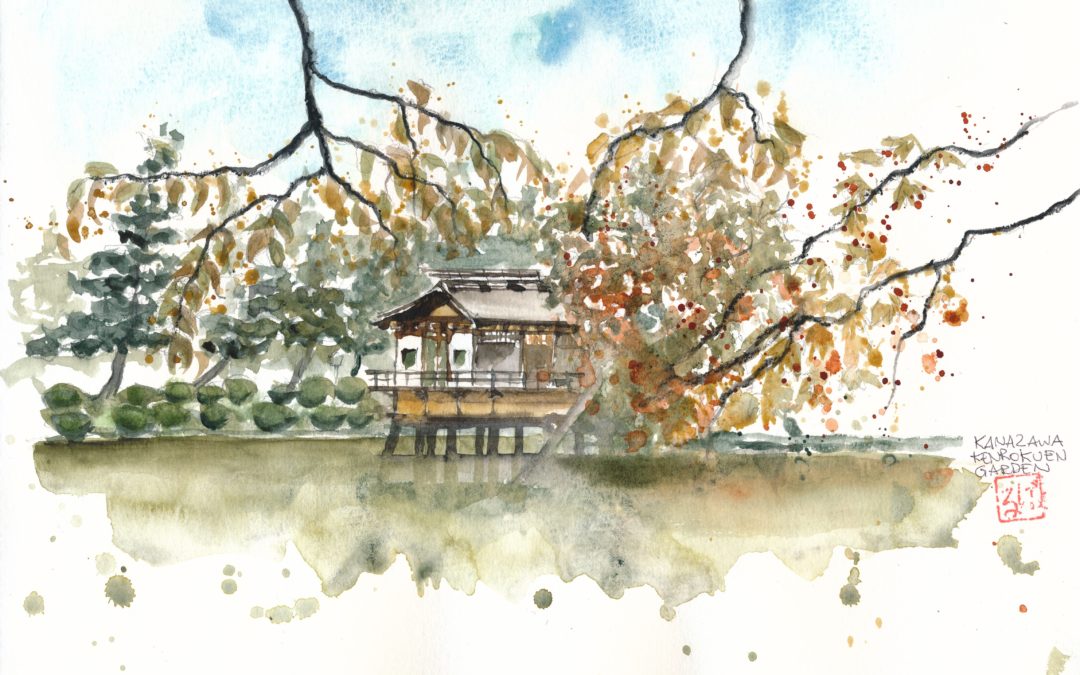Hello my dear!
Here’s another video I made in Kanazawa. It’s the same tea house as in the previous video, but seen from the other side of the lake.
First I made the drawing in pencil (I use Palomino Blackwing pencil medium hard graphite.) and then I started painting.
There’s some explanation in the video.
It’s an A4 – sized watercolour sketchbook from “Seawhite of Brighton”. The paper is very white! I still have to get used to it.
I use my pocket palette boxes: one with warm and one with cold colours, filled with Daniel Smith and Winsor & Newton tube paints. They’re very light and small so easy to travel with.
I use a mop brush (sable, Isabey), a diagonal brush (sword sable, Rosemary & co) and a fine brush (Winsor & Newton series 7) and Viarco water-soluble graphite.
I first started by the water of the lake and splashes of green to “destroy” the whiteness of my paper, otherwise I tend to become too delicate and afraid to make mistakes…
I tried to pay attention to make the main objects (the tea house on the lake) in dark contrasts warm colours, and the vegetation which are further away in lighter contrasts, less detailed and lighter cooler colours. (this could have been done better….) This creates depth. Also the trees which are closest to me are painted darker and warmer, and drawn with more detail then the vegetation which is further away.
Here’s an important “trick” to keep in mind we already talked about:
To avoid overwhelm, look at your subject as just “a bunch of lines”
How do you look at the building you want to draw? How do you look at the Musée du Louvre to draw it? If you look at it as the Musée du Louvre with the impressive perspective and sculptures, cold sweat and fear will take over. If you look at it simply as a bunch of lines that you want to suggest on the paper (and so it doesn’t matter really if some of them will be missing), then it starts to be fun. So don’t see the building as a building, and don’t try to draw everything. And also: it doesn’t matter if you drawing isn’t “correct” ! Who cares? If we want to see all the lines and all the sculptures it’s better to take a photograph, isn’t it?
Try different ways also of holding your pencil, brush, pen. Hold it loosely, and not as if you were writing. Draw with your whole arm and body, not just with the tip of your fingers.
To be able to see the building as a bunch of lines, what you have to do is look with your eyes, and not with your brain. Look with your eyes to the lines, to the contours of surfaces and draw them. Don’t look with your brain to the building, windows, chairs, glass or whatever you want to draw. Just look at the edges of the subject and in which direction the lines are going. If you don’t see in which directions the lines are going, make a plastic sheet with a grid on it and look through the plastic sheet. It’s a great help sometimes.
Draw slooooooooowly, line by line. Look carefully (75% of the time to the subject, 25% to the paper). Try not to lift up your pen. Draw and make it grow organically. Pay attention to the direction in which the lines are going and how long they are, how they relate to one another. Try to draw the correct proportions. How wide is the window in comparison to the height? Slow down and look carefully. And put it onto the paper.
And finally: don’t be a perfectionist. You have the permission to experiment and to make lousy, “incorrect” drawings. Who cares if a window or two, three, six, are missing in your drawing? We’re not copy machines. We just make drawings…. There are no bad drawings. Let it go and take risks. Life is too short to count windows (dixit Ian Fennelly)
Now stop reading this and get to #work. Because to improve yourself, you have to do the work. There’s no shortcut to that…
Tell me, what are you struggling with most?
Love,
Barbara


Great video, thanks for the explanations. And the result is a beautiful sketch!
Progress, not perfection… I guess I have a mantra for this year!
Thank you so much dear Mariana
Enjoyed your video. Thanks for the list of supplies. My kids are taking me to Paris for a week in Sept. celebrating my 80th. I want to remember the trip not with just photos but with a sketchbook of watercolors. I will be traveling with four others so don’t want to slow them down. I’m thinking there will be opportunity to do quick sketches and then follow up later in hotel to watercolor. Between now and the trip I plan to get out and do as much outdoor sketches as i can. Do you have any other suggestions
Thank you so much dear Barbara
Try to find some time for sketching is always a challenge.
If you’re travelling with non-sketchers maybe it’s best to concentrate on small detail sketching so you don’t get stressed by time. Take a small sketchbook
I love this video. I have just started sketching as a way of slowing down and paying attention to what is in front of me, and I am loving the practice. Thank you for sharing your process.
Thank you so much dear Danielle!
Enjoy !
Hello from Kanazawa! Wonderful. It was a pleasure to watch you. I’m looking forward to
doing some splattering! And buying a mop brush and a fine brush . . . Best wishes. Kevin
Have fun ‼️
As always your words and art are a great inspiration, carry on the good work.
OHH thank you so much Patrick ! You make me very happy now! I’m always in doubt… 😉